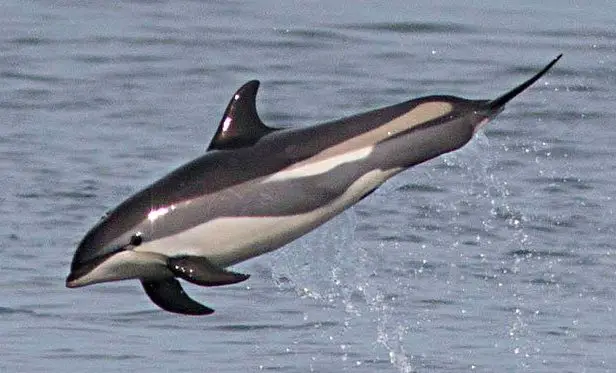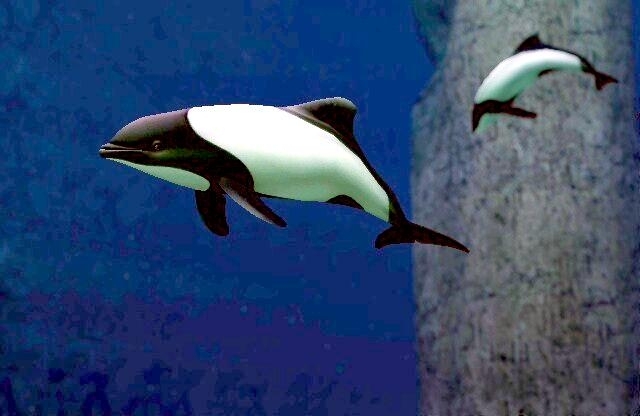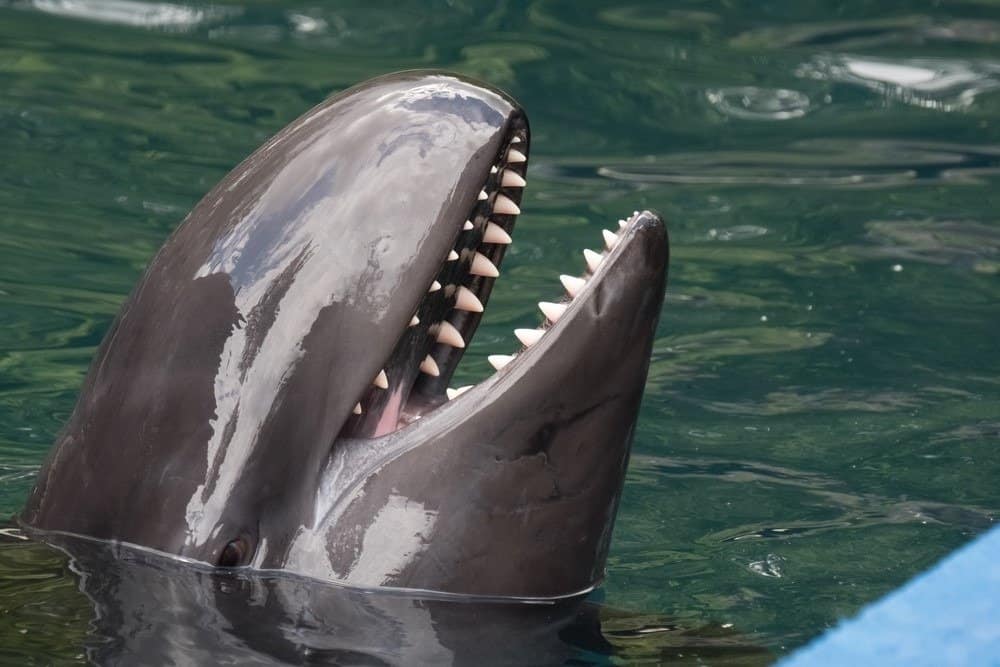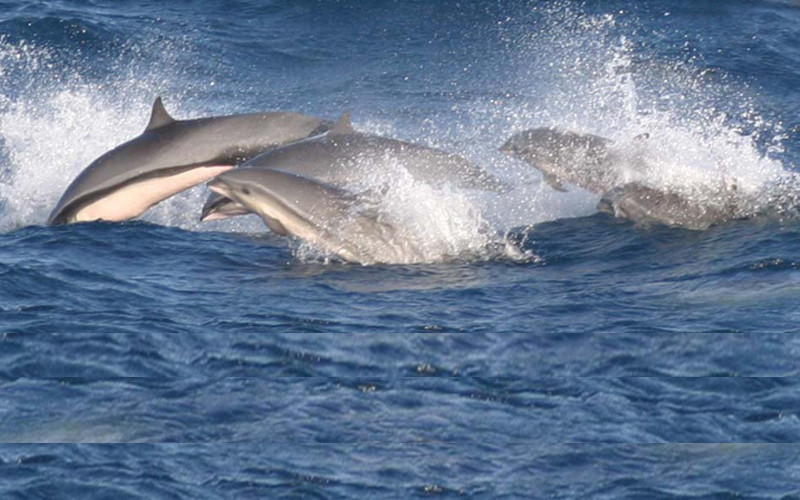by Active Wild Admin
6/29/2023
Dolphins are marine mammals belonging to the infraorder Cetacea, which is also home to whales & porpoises. Known for their high intelligence & acrobatic displays, dolphins are among the most familiar & best-loved members of the animal kingdom.
The 2 main types of dolphins are oceanic dolphins (family Delphinidae), & river dolphins (various families). The majority of dolphins are oceanic dolphins; only a handful of species are found in freshwater habitats.
Atlantic Humpback Dolphin
Scientific Name: Sousa teuszii
Family: Delphinidae
Length: 2.5 to 2.8 meters (8.2 to 9.2 feet)
Weight: 150 to 200 kg (330 to 440 lbs)
Where found: Coastal waters of West Africa
Conservation status: Critically Endangered
The Atlantic humpback dolphin is a member of the humpback dolphin genus Sousa – a group of dolphins known for their distinctive humped backs.
The Atlantic humpback dolphin is gray to white in color & has fewer teeth than other humpback dolphins.
This species is endemic to the Eastern Atlantic, being found off the west coast of Africa from Western Sahara to Angola, often within close range of land.
The Atlantic humpback dolphin lives in small groups. Due to habitat loss, incidental catch, & other threats, this species is critically endangered.
Atlantic Spotted Dolphin
Scientific Name: Stenella frontalis
Family: Delphinidae
Length: 1.8 to 2.4 meters (5.9 to 7.9 feet)
Weight: 80 to 130 kg (176 to 286 lbs)
Where found: Warm & tropical waters of the Atlantic Ocean
Conservation status: Least Concern
Atlantic Spotted Dolphins have a slender body with a distinct dark dorsal cape & spots covering their light gray or white sides.
This species is highly social, usually living in groups of up to 15 individuals, & often associating with other dolphin species, including the common bottlenose dolphin, with which the Atlantic spotted dolphin has been known to successfully breed.
Atlantic White-Sided Dolphin
Scientific Name: Lagenorhynchus acutus
Family: Delphinidae
Length: 2.5 to 3 meters (8.2 to 9.8 feet)
Weight: 200 to 350 kg (440 to 770 lbs)
Where found: North Atlantic Ocean, particularly in cool-temperate & subarctic waters
Conservation status: Least Concern
Atlantic white-sided dolphins are large dolphins with a highly-distinctive color pattern: a dark gray back, white or light gray belly, & a pale yellow-gray patch behind the dorsal fin. They are acrobatic, & will often interact with boats.
Australian Humpback Dolphin
Scientific Name: Sousa sahulensis
Family: Delphinidae
Length: 2.6 to 2.8 meters (8.5 to 9.2 feet)
Weight: 200 to 230 kg (440 to 507 lbs)
Where found: Northern coasts of Australia & the waters around New Guinea
Conservation status: Vulnerable
The Australian humpback dolphin was identified as a separate species in 2014.
Like other humpback dolphins, the species has a hump on its back. It is silver-gray in color, with pale fins & a dark gray back. It is found in the coastal waters, estuaries, & rivers along the northern half of Australia, from the Queensland-New South Wales border in the east to Shark Bay in Western Australia.
The species is rated “Vulnerable” due to habitat degradation, pollution, & accidental by-catch.
Australian Snubfin Dolphin
Scientific Name: Orcaella heinsohni
Family: Delphinidae
Length: Up to 2.7 meters (approximately 8.9 feet)
Weight: Up to 139 kg (approximately 306 lbs)
Where found: Coastal waters of northern Australia
Conservation status: Vulnerable
The Australian Snubfin Dolphin was recognized as a distinct species in 2005 (until then, it & the closely-related Irrawaddy dolphin were considered the same species). Its name refers to the short, blunt dorsal fin on its back.
The species has a 3-color pattern, which distinguishes it from the Irrawaddy dolphin (which has 2 colors). It is an opportunistic, generalist feeder, that eats a wide variety of fish.
Chilean Dolphin
Scientific Name: Cephalorhynchus eutropia
Family: Delphinidae
Length: Up to 1.7 meters (approximately 5.6 feet)
Weight: Up to 60 kg (approximately 132 lbs)
Where found: Coastal Chile in the cold, shallow waters of the southeastern Pacific Ocean
Conservation status: Near Threatened
Also known as the Black Dolphin, the Chilean Dolphin is one of the smallest cetacean species. It has a robust build, with a rounded head & no beak, & is occasionally mistaken for a porpoise. Its body is dark grey to black, with a white underside.
Unlike many other dolphin species, the Chilean Dolphin is relatively shy & elusive. It is usually seen in small pods of up to 10 individuals.
Clymene Dolphin
Scientific Name: Stenella clymene
Family: Delphinidae
Length: Up to 2 meters (approximately 6.6 feet)
Weight: Up to 75-80 kg (approximately 165-176 lbs)
Where found: Tropical & subtropical Atlantic Ocean
Conservation status: Least Concern
Also known as the short-snouted spinner dolphin, the Clymene dolphin has a slender body with 3 main colors: dark gray back & sides, paler gray on the throat & sides, & white undersides. The species is known for its long, slender beak, & its impressive acrobatics, & is often seen leaping & spinning out of the water.
The Clymene dolphin’s ancestors were hybrids of the spinner dolphin & striped dolphin, & the species has characteristics of both. It is the only known example of hybrid speciation (the process whereby a new species evolves as a result of hybridization) in cetaceans.
Commerson's Dolphin
Scientific Name: Cephalorhynchus commersonii
Family: Delphinidae
Length: 1.5 to 2.5 meters (4.9 to 8.2 feet)
Weight: 35 to 85 kg (77 to 187 lbs)
Where found: Coastal waters of the southernmost parts of South America & around the Kerguelen Islands in the Indian Ocean
Conservation status: Least Concern
Commerson's Dolphins are known for their striking black & white patterning. One of the smallest dolphin species, they have a robust build & a rounded dorsal fin. They are energetic & acrobatic, often seen riding the bow wave created by boats. Their diet consists of fish & squid.
Commerson's Dolphin is named after French naturalist Philibert Commerson, who discovered the species as he circumnavigated the globe in an expedition led by admiral & explorer Louis Antoine de Bougainville.
Common Bottlenose Dolphin
Scientific Name: Tursiops truncatus
Family: Delphinidae
Length: Between 2 to 4 meters (6.6 to 13.1 feet)
Weight: Between 150 to 650 kg (330 to 1430 lbs)
Where found: Widely distributed around the world in both offshore & coastal areas, including harbors, bays, gulfs, & estuaries of temperate & tropical waters.
Conservation status: Least Concern
The common bottlenose dolphin is one of the most well-known dolphin species due to its use in aquarium shows & movies. The species is known both for its intelligence & its acrobatic behavior.
The common bottlenose dolphin is grey in color, with a lighter underside. It has a varied diet that includes fish & squid.
Common Dolphin
Scientific Name: Delphinus delphis
Family: Delphinidae
Length: 1.9 to 2.5 meters (6.2 to 8.2 feet)
Weight: 80 to 150 kg (176 to 330 lbs)
Where found: Warm & tropical seas worldwide
Conservation status: Least Concern
The common dolphin is the world’s most abundant cetacean, with a global population numbering several million.
Known for its playful behavior & agility, the common dolphin is popular with watchers of marine wildlife. It is a mid-sized species with a dark gray-black back, white belly, & distinctive pale grey, yellow or gold hourglass-shaped patch on its sides.
Dusky Dolphin
Scientific Name: Lagenorhynchus obscurus
Family: Delphinidae
Length: 1.7 to 2 meters (5.6 to 6.6 feet)
Weight: 70 to 85 kg (154 to 187 lbs)
Where found: Cool waters of the South Atlantic & South Pacific Oceans
Conservation status: Least Concern
The dusky dolphin is a small, robust cetacean known for its impressive acrobatics. It is easily identified by its short, curved dorsal fin & a complex, striking body pattern with a dark gray or black back, white underside, & characteristic light gray patch on the flank, extending from the tail to the center of the body.
Dusky dolphins inhabit cool, upwelling-rich waters of the Southern Hemisphere, particularly around South America, New Zealand, & some parts of Africa. They are primarily coastal but can also be found in offshore waters.
The dusky dolphin is known for its social nature & is often seen in large groups, sometimes numbering in the hundreds. The species’ acrobatic displays, including leaps, backslaps, & belly flops, are a spectacle to behold, making it a favorite among wildlife enthusiasts.
False Killer Whale
Scientific Name: Pseudorca crassidens
Family: Delphinidae
Length: 4.9 to 6 meters (16 to 20 feet)
Weight: 1,200 to 2,200 kg (2,600 to 4,900 lbs)
Where found: Found in tropical, subtropical, & temperate waters throughout the world
Conservation status: Near Threatened
The false killer whale, despite its name, is not directly related to the killer whale, or orca. The species is named for the similarity of its skull with that of the orca.
A large dolphin, the false killer whale typically measures up to 6 meters in length & can weigh as much as 1,500 kilograms. It is characterized by its elongated, slim body, rounded overhanging forehead, & small, conical, slightly upturned snout.
False killer whales are highly sociable & known for their playful behavior & occasional mass strandings. They are found throughout the world's tropical & temperate seas & have a preference for deep, open ocean environments.
False killer whales are known to share food among group members, highlighting their strong social bonds. The species has the IUCN conservation status 'Near Threatened' due to its low reproduction rates & threats such as bycatch, marine pollution, & reduction in prey from overfishing.
Fraser's Dolphin
Scientific Name: Lagenodelphis hosei
Family: Delphinidae
Length: 2.6 to 2.7 meters (8.5 to 8.9 feet)
Weight: 200 kg (440 lbs)
Where found: Deep waters of the Pacific & Indian Oceans
Conservation status: Least Concern
Fraser's dolphin is a lesser-known dolphin species known for its small beak, robust, torpedo-shaped body, & a notably small dorsal fin relative to its body size. It has a striking color pattern, with a gray back & white undersides separated by a dark stripe that runs from the face, around the eye, & along the flanks.
Found in deep waters of the tropical Pacific & Atlantic Oceans, Fraser's dolphin is a highly social species, often traveling in large groups, sometimes numbering in the thousands. It is known to be a fast swimmer.
Guiana Dolphin
Scientific Name: Sotalia guianensis
Family: Delphinidae
Length: 1.7 to 2.2 meters (5.6 to 7.2 feet)
Weight: 40 to 60 kg (88 to 132 lbs)
Where found: Coastal areas & estuaries along eastern South America
Conservation status: Near Threatened
The Guiana dolphin, also known as the Costero or estuarine dolphin, looks like a small bottlenose dolphin, & has a robust build & prominent beak.
The species is found close to the Atlantic coast of South & Central America, & is known to venture into freshwater habitats. It is generally found in small groups of 2-10 individuals.
Guiana dolphins are known to herd fish onto the shore, momentarily stranding themselves in order to capture their prey.
Heaviside's Dolphin
Scientific Name: Cephalorhynchus heavisidii
Family: Delphinidae
Length: 1.7 to 2 meters (5.6 to 6.6 feet)
Weight: 75 to 80 kg (165 to 176 lbs)
Where found: Cold coastal waters off Namibia & the west coast of South Africa
Conservation status: Near Threatened
Heaviside's dolphin is a small, robust species with a dark grey top, lighter flanks, & a white belly. It is known for its acrobatic behavior & is often seen breaching & surfing in waves. Its diet consists mostly of fish & cephalopods.
Hector's Dolphin
Scientific Name: Cephalorhynchus hectori
Family: Delphinidae
Length: 1.2 to 1.6 meters (3.9 to 5.2 feet)
Weight: 40 to 60 kg (88 to 132 lbs)
Where found: Coastal waters of New Zealand
Conservation status: Endangered
Hector's dolphin is one of the smallest dolphin species in the world, & the only species found only in New Zealand. It has a unique rounded dorsal fin & has a pale grey body with dark head & fins.
This species is generally found in small groups & feeds on a variety of fish & squid.
Hourglass Dolphin
Scientific Name: Lagenorhynchus cruciger
Family: Delphinidae
Length: 1.8 to 1.9 meters (5.9 to 6.2 feet)
Weight: 90 to 120 kg (198 to 264 lbs)
Where found: Cold waters of the Southern Hemisphere, particularly around Antarctica
Conservation status: Least Concern
The hourglass dolphin is a relatively small species, named for the distinctive white, elongated "hourglass" pattern on its dark body. It has a short beak & a tall, curved dorsal fin
This dolphin inhabits the cold, sub-Antarctic waters of the Southern Hemisphere. It is usually seen in groups typically containing fewer than 10 individuals, but gatherings of up to 100 individuals are known.
While not much is known about the species’ behavior due to its remote habitat, it is known to be a fast swimmer & capable of spectacular aerial displays, often seen leaping & riding swells & waves.
Indian Ocean Humpback Dolphin
Scientific Name: Sousa plumbea
Family: Delphinidae
Length: 2.5 to 2.8 meters (8.2 to 9.2 feet)
Weight: 150 to 200 kg (330 to 440 lbs)
Where found: Coastal waters of the Indian Ocean from South Africa to India
Conservation status: Endangered
Like other humpback dolphins, the Indian Ocean humpback dolphin has a hump below the dorsal fin. It is generally grey to pink in color.
The Indian Ocean humpback dolphin is found along the coasts of the Indian Ocean, ranging from South Africa to India & as far east as the western borders of Thailand.
Indo-Pacific Bottlenose Dolphin
Scientific Name: Tursiops aduncus
Family: Delphinidae
Length: Between 2 to 2.6 meters (6.6 to 8.5 feet)
Weight: Between 150 to 230 kg (330 to 507 lbs)
Where found: Warm temperate to tropical Indian & Pacific Oceans
Conservation status: Near Threatened
The Indo-Pacific bottlenose dolphin is similar in appearance to the closely-related common bottlenose dolphin but generally smaller, with a relatively long snout & spots on its sides. It is dark grey, with paler undersides.
Known for its playful & curious nature, the Indo-Pacific bottlenose dolphin's diet primarily consists of fish & cephalopods.
Indo-Pacific Humpback Dolphin
Scientific Name: Sousa chinensis
Family: Delphinidae
Length: 2.5 to 2.8 meters (8.2 to 9.2 feet)
Weight: 150 to 200 kg (330 to 440 lbs)
Where found: Coastal waters from eastern India to southeastern China, the Philippines, & northern Australia
Conservation status: Vulnerable
Also known as the Chinese white dolphin, the Indo-Pacific humpback dolphin is found in shallow coastal waters in the Indo-Pacific region.
The species is characterized by a hump below the dorsal fin & a pale gray / white coloration, with some populations having a unique pink coloration.
Cute Critter Pics:

/atlantic-spotted-dolphin-and-calf-56b6c0983df78c0b135b9edd.jpg)





tiger.webp)



No comments:
Post a Comment